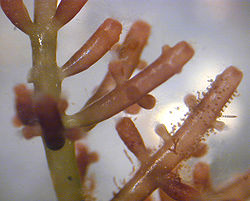Algae
Algae are a diverse group of water-dwelling organisms which are photosynthetic like plants and have unicellular forms, or simpler multicellular forms lacking the organs of land plants. The most complex marine forms are called seaweeds, including kelp. Algae live in water, are at the bottom of the food chain, and thus all life depends on them. Algae are usually found in all water except distilled, even in rainwater.
The scientific study of algae is called phycology. Phycologists generally specialize in one of these specialties:
- freshwater diatoms (with skeletal structures)
- freshwater soft algae (also called non-diatoms; including underwater plants)
- marine (salt-water) diatoms (with skeletal structures)
- marine (salt-water) soft algae (also called non-diatoms; including seaweeds)
Because there are thousands of species of algae in each of the above specialties, management of taxonomic lists for each specialty is a complex and critical element in each field. For example, in freshwater diatoms, two to three thousand species are known, but scientists expect there are over ten thousand species in existence. During counting via microscopes, new species are constantly being found. When phycologists have found a sufficient number of new species, they publish the names and descriptions of them for the use of other scientists, but in this process, invariably duplicate names arise for some of the new species. In order to make algae studies viable over time and place, the conflicting names need to be normalized. It is this process of naming and normalizing new species that makes taxonomy so important in algae studies, because without it, an algae study in a lake from the 1960's cannot be adequately compared with one from 2020, for example, because some of the names used in either study may have since been changed by consensus among scientists. So taxonomic "normalization" is only possible if the industry of phycologists counting algae are working cooperatively to manage species names over time. However, funding for such taxonomic work is extremely rare.
